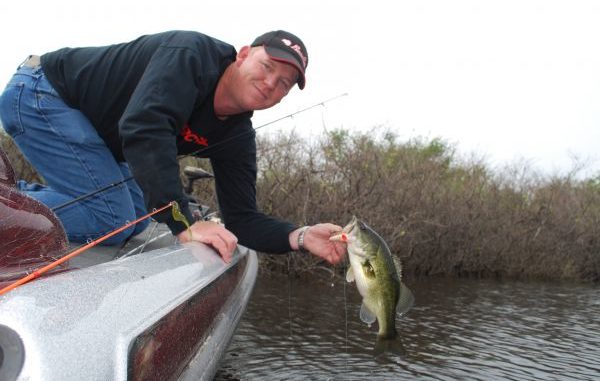
“Topwater bass fishing isn’t all that complicated,” Stephen Mitchell explained. “You just got to figure out what they want. Sometimes they want it really erratic. Sometimes, like today, they like it chug-and-stop style.”
His father Gerald agreed.
“Today, they really want the cadence pretty slow,” he said. “Lots of them are hitting it when it is stopped. If you think that you are in fish but not getting the hits you think you should, try stopping the lure.”
As to the widely held belief that topwaters are not as effective as other lures because they are only early morning and late-evening lures, both men disagree.
“A lot of people say that only the first hour is good for topwaters. I most definitely fish them all day in this area,” Stephen said with conviction.
From the back of the boat, Gerald chimed in.
“They might slow down in mid-day, but the quality of the fish is better,” Gerald said. “These fish are down in the grass; they aren’t in the open.”
By quality, he clearly meant size.
While the father-son duo agreed on a lot, they diverged on lure color.
“I normally want one with a bone-colored bottom,” Gerald smiled, expecting his son to rebut, which he did.
“And I’m the opposite: I like an orange belly,” Stephen said.
“It’s all what you have confidence in,” observed the elder Mitchell.
Both anglers are particular about the knots they use to attach their lures. Gerald typically puts four or five half-hitches above a Palomar knot. This, he explained, cocks the line downward from the eye and keeps the bait from diving beneath the surface, ruining its action.
Stephen uses another wrinkle to accomplish the same thing” He will add one or two SuspenStrips, adhesive-backed lead strips, to rear of the lure to effectively lifting its nose up and preventing diving.
“Those strips are really good,” Gerald agreed. “They can be used on a lot of baits to add weight by wrapping them around the hooks.
Both men also think that good rods and reels are important for topwater work.
“Rod length is a matter of choice,” Gerald opined, “but you need a rod with some backbone to twitch a topwater lure right.
Stephen went straight to his choice of reels — an Abu Garcia Revo SX level wind.
“It’s one of the few with a 7:1 gear ratio and a 20-pound max drag setting,” he explained.
Gerald was more liberal in his reel recommendation, noting that “there are a lot of good brands out there.” But he added, “Buy a good, smooth one with several ball bearings. Expect to pay over $100. With a better reel you can cast farther. Sometimes that makes a difference.”